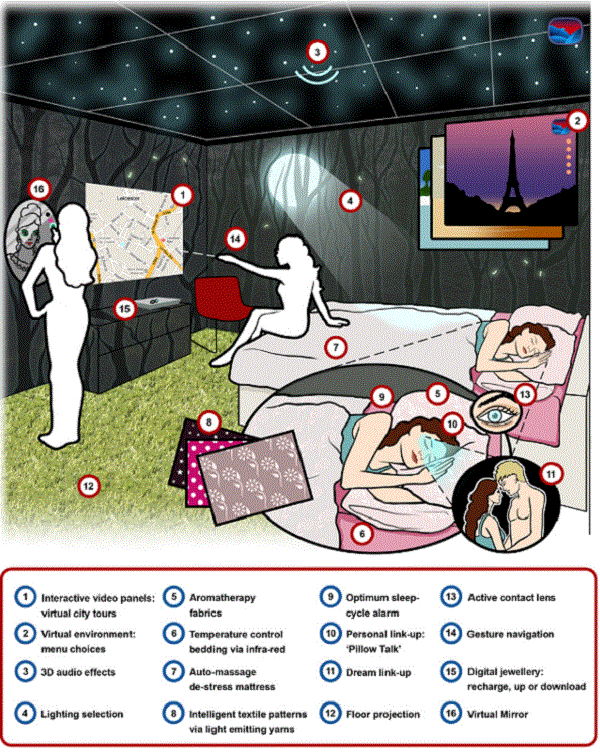WORLDWIDE Interactive dreaming, virtual love-making, sleep studying and health monitoring are among the technological advancements that could become commonplace in hotels 20 years from now, according to futurologist Ian Pearson.
In a report commissioned by Travelodge Hotels Ltd., Pearson predicts that hotel guestrooms of the future will be so technologically advanced that they will almost be alive, fulfilling guests’ needs like a personal concierge, lifestyle coach, fitness trainer, psychologist and doctor. Cutting-edge technology will monitor customers’ energy levels, physical well-being, emotions and mood to help ensure they achieve a good night’s sleep.
By 2030, technology will exist that will enable content management of dreams, similar to concepts depicted in the movie “Inception.” Video, audio, smells and tactile experiences produced using the bed or bed linens will play a key role in making dreams feel real. People will also be able to replay favorite dreams from a menu, akin to selecting a movie from a list of downloads. Also, people will be able to link into dreams with friends to enjoy a shared dream experience, according to Pearson.
This dream management system will also act as a coach, offering the opportunity to study or even learn a new language while asleep.
Remote virtual love making will be possible by 2030, allowing individuals to connect with a partner while away from home. Couples will benefit from the ability to link peripheral nervous systems via active skin electronics together for enhanced love making. This will enable both individuals to experience each other’s feelings and emotions. Also, by wearing active lenses to change the image delivered to their retinas, individuals will be able to adjust how their partner looks while making love. This will enable people to change the image of their partner on a regular basis, and only they will be aware as their lover will not be able to tell what they are looking at.
By 2030 it will be possible to diagnose some medical conditions by monitoring sleep patterns, Pearson says. Sleepwear featuring electro-responsive fabrics will enable measurement of skin conductivity (indicating stress or relaxation states), pulse, blood pressure and quality of heart signals.
Active contact lenses will allow sleepers in the future to watch TV, watch movies or check email as they fall asleep. The lenses will be worn under the eyelids and deliver high quality 3D images directly onto the retina.
Sleepwear of the future will feature electronically controllable properties that can gently massage sleepers or play active roles in dreams, linking with imagery and sounds to create a fully tactile dreamscape.
Sleep-cycle alarms will monitor the electrical activity in the brain and identify the best time for the sleeper to wake up, ensuring their sleep cycle is completed.
“On average we spend a third of our lives asleep, and this will still be the case in 2030,” Pearson says. “Technology will not change our basic need to slumber, but it will certainly enhance the experience, enabling sleep to have much greater value than merely rest and recuperation.”
Hotel guests in 2030 will still want a good night’s sleep in comfortable surroundings. The key difference is that the experience will be personalized to individual needs and tastes. This technology will monitor and anticipate physical, emotional and mental needs and desires for a healthier and happier state of being.
Almost any surface or fabric in the 2030 hotel room will be capable of electronic enhancement, whether it is scent production, acting as a visual display or speaker, or as a source of ambient sound.
Augmented reality will enable the entire surface of the hotel walls and furniture to be used as any kind of display—art, computer monitor, virtual game or fantasy location, for example. Lonely guests will be able to upload virtual family images or a picture of their home bedroom, making them feel truly at home.
Atmospheric temperature control air conditioning will allow guests to alter their room climate to stimulate the ambience of a seaside, forest or being surrounded by mountains. Outdoor sounds from flat-panel audio built into the window will bring in the sound of the ocean or a forest to accompany their fantasy room view.
Soft surfaces such as fabrics will interact in tactile ways to produce scents, change colors and pick up signals from the skin. Guests will be able to instantly change the color, pattern and texture of their room furnishings.
Guests will be able to attend a local theatrical production, explore some local tourist attractions or just wander through town, all remotely from the comfort of their guestrooms. They would be able to do any time regardless of the actual time or weather.
Guests will be able to shop from the guestroom, with the walls replicating the interior of a shop. In the same way, guests could enter into the world of computer games and play the actual character, within the dimensions of their guestroom. Individuals would be able to link up with other guests and play virtual reality games between guestrooms.
Electronic mirrors in 2030 will offer guests 360-degree views, and it will be able to simulate different makeup looks and hairstyles before application.

